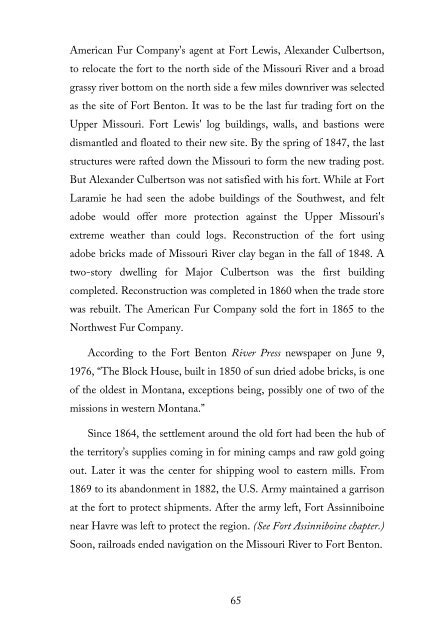Montana's DAR Markers . . . Honoring Where History Was Made
This book is a 200-page thank you to the women of Montana State Society Daughters of the American Revolution for their work in placing historical markers across the state of Montana. Starting in 1908, Montana DAR has installed 70 historical markers across the state. Of those, 33 remain. This book records why the markers’ sites were selected, their history, and the backstory of each.
This book is a 200-page thank you to the women of Montana State Society Daughters of the American Revolution for their work in placing historical markers across the state of Montana. Starting in 1908, Montana DAR has installed 70 historical markers across the state. Of those, 33 remain. This book records why the markers’ sites were selected, their history, and the backstory of each.
You also want an ePaper? Increase the reach of your titles
YUMPU automatically turns print PDFs into web optimized ePapers that Google loves.
American Fur Company's agent at Fort Lewis, Alexander Culbertson,<br />
to relocate the fort to the north side of the Missouri River and a broad<br />
grassy river bottom on the north side a few miles downriver was selected<br />
as the site of Fort Benton. It was to be the last fur trading fort on the<br />
Upper Missouri. Fort Lewis' log buildings, walls, and bastions were<br />
dismantled and floated to their new site. By the spring of 1847, the last<br />
structures were rafted down the Missouri to form the new trading post.<br />
But Alexander Culbertson was not satisfied with his fort. While at Fort<br />
Laramie he had seen the adobe buildings of the Southwest, and felt<br />
adobe would offer more protection against the Upper Missouri's<br />
extreme weather than could logs. Reconstruction of the fort using<br />
adobe bricks made of Missouri River clay began in the fall of 1848. A<br />
two-story dwelling for Major Culbertson was the first building<br />
completed. Reconstruction was completed in 1860 when the trade store<br />
was rebuilt. The American Fur Company sold the fort in 1865 to the<br />
Northwest Fur Company.<br />
According to the Fort Benton River Press newspaper on June 9,<br />
1976, “The Block House, built in 1850 of sun dried adobe bricks, is one<br />
of the oldest in Montana, exceptions being, possibly one of two of the<br />
missions in western Montana.”<br />
Since 1864, the settlement around the old fort had been the hub of<br />
the territory’s supplies coming in for mining camps and raw gold going<br />
out. Later it was the center for shipping wool to eastern mills. From<br />
1869 to its abandonment in 1882, the U.S. Army maintained a garrison<br />
at the fort to protect shipments. After the army left, Fort Assinniboine<br />
near Havre was left to protect the region. (See Fort Assinniboine chapter.)<br />
Soon, railroads ended navigation on the Missouri River to Fort Benton.<br />
65





